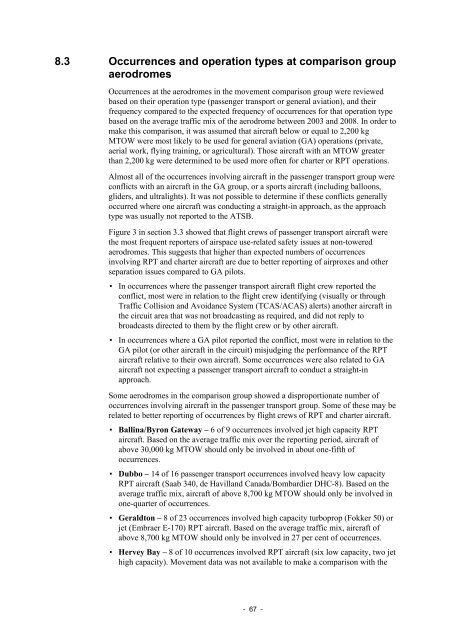Safety in the vicinity of non-towered aerodromes - Australian ...
Safety in the vicinity of non-towered aerodromes - Australian ...
Safety in the vicinity of non-towered aerodromes - Australian ...
Create successful ePaper yourself
Turn your PDF publications into a flip-book with our unique Google optimized e-Paper software.
8.3 Occurrences and operation types at comparison group<br />
<strong>aerodromes</strong><br />
Occurrences at <strong>the</strong> <strong>aerodromes</strong> <strong>in</strong> <strong>the</strong> movement comparison group were reviewed<br />
based on <strong>the</strong>ir operation type (passenger transport or general aviation), and <strong>the</strong>ir<br />
frequency compared to <strong>the</strong> expected frequency <strong>of</strong> occurrences for that operation type<br />
based on <strong>the</strong> average traffic mix <strong>of</strong> <strong>the</strong> aerodrome between 2003 and 2008. In order to<br />
make this comparison, it was assumed that aircraft below or equal to 2,200 kg<br />
MTOW were most likely to be used for general aviation (GA) operations (private,<br />
aerial work, fly<strong>in</strong>g tra<strong>in</strong><strong>in</strong>g, or agricultural). Those aircraft with an MTOW greater<br />
than 2,200 kg were determ<strong>in</strong>ed to be used more <strong>of</strong>ten for charter or RPT operations.<br />
Almost all <strong>of</strong> <strong>the</strong> occurrences <strong>in</strong>volv<strong>in</strong>g aircraft <strong>in</strong> <strong>the</strong> passenger transport group were<br />
conflicts with an aircraft <strong>in</strong> <strong>the</strong> GA group, or a sports aircraft (<strong>in</strong>clud<strong>in</strong>g balloons,<br />
gliders, and ultralights). It was not possible to determ<strong>in</strong>e if <strong>the</strong>se conflicts generally<br />
occurred where one aircraft was conduct<strong>in</strong>g a straight-<strong>in</strong> approach, as <strong>the</strong> approach<br />
type was usually not reported to <strong>the</strong> ATSB.<br />
Figure 3 <strong>in</strong> section 3.3 showed that flight crews <strong>of</strong> passenger transport aircraft were<br />
<strong>the</strong> most frequent reporters <strong>of</strong> airspace use-related safety issues at <strong>non</strong>-<strong>towered</strong><br />
<strong>aerodromes</strong>. This suggests that higher than expected numbers <strong>of</strong> occurrences<br />
<strong>in</strong>volv<strong>in</strong>g RPT and charter aircraft are due to better report<strong>in</strong>g <strong>of</strong> airproxes and o<strong>the</strong>r<br />
separation issues compared to GA pilots.<br />
• In occurrences where <strong>the</strong> passenger transport aircraft flight crew reported <strong>the</strong><br />
conflict, most were <strong>in</strong> relation to <strong>the</strong> flight crew identify<strong>in</strong>g (visually or through<br />
Traffic Collision and Avoidance System (TCAS/ACAS) alerts) ano<strong>the</strong>r aircraft <strong>in</strong><br />
<strong>the</strong> circuit area that was not broadcast<strong>in</strong>g as required, and did not reply to<br />
broadcasts directed to <strong>the</strong>m by <strong>the</strong> flight crew or by o<strong>the</strong>r aircraft.<br />
• In occurrences where a GA pilot reported <strong>the</strong> conflict, most were <strong>in</strong> relation to <strong>the</strong><br />
GA pilot (or o<strong>the</strong>r aircraft <strong>in</strong> <strong>the</strong> circuit) misjudg<strong>in</strong>g <strong>the</strong> performance <strong>of</strong> <strong>the</strong> RPT<br />
aircraft relative to <strong>the</strong>ir own aircraft. Some occurrences were also related to GA<br />
aircraft not expect<strong>in</strong>g a passenger transport aircraft to conduct a straight-<strong>in</strong><br />
approach.<br />
Some <strong>aerodromes</strong> <strong>in</strong> <strong>the</strong> comparison group showed a disproportionate number <strong>of</strong><br />
occurrences <strong>in</strong>volv<strong>in</strong>g aircraft <strong>in</strong> <strong>the</strong> passenger transport group. Some <strong>of</strong> <strong>the</strong>se may be<br />
related to better report<strong>in</strong>g <strong>of</strong> occurrences by flight crews <strong>of</strong> RPT and charter aircraft.<br />
• Ball<strong>in</strong>a/Byron Gateway – 6 <strong>of</strong> 9 occurrences <strong>in</strong>volved jet high capacity RPT<br />
aircraft. Based on <strong>the</strong> average traffic mix over <strong>the</strong> report<strong>in</strong>g period, aircraft <strong>of</strong><br />
above 30,000 kg MTOW should only be <strong>in</strong>volved <strong>in</strong> about one-fifth <strong>of</strong><br />
occurrences.<br />
• Dubbo – 14 <strong>of</strong> 16 passenger transport occurrences <strong>in</strong>volved heavy low capacity<br />
RPT aircraft (Saab 340, de Havilland Canada/Bombardier DHC-8). Based on <strong>the</strong><br />
average traffic mix, aircraft <strong>of</strong> above 8,700 kg MTOW should only be <strong>in</strong>volved <strong>in</strong><br />
one-quarter <strong>of</strong> occurrences.<br />
• Geraldton – 8 <strong>of</strong> 23 occurrences <strong>in</strong>volved high capacity turboprop (Fokker 50) or<br />
jet (Embraer E-170) RPT aircraft. Based on <strong>the</strong> average traffic mix, aircraft <strong>of</strong><br />
above 8,700 kg MTOW should only be <strong>in</strong>volved <strong>in</strong> 27 per cent <strong>of</strong> occurrences.<br />
• Hervey Bay – 8 <strong>of</strong> 10 occurrences <strong>in</strong>volved RPT aircraft (six low capacity, two jet<br />
high capacity). Movement data was not available to make a comparison with <strong>the</strong><br />
- 67 -
















